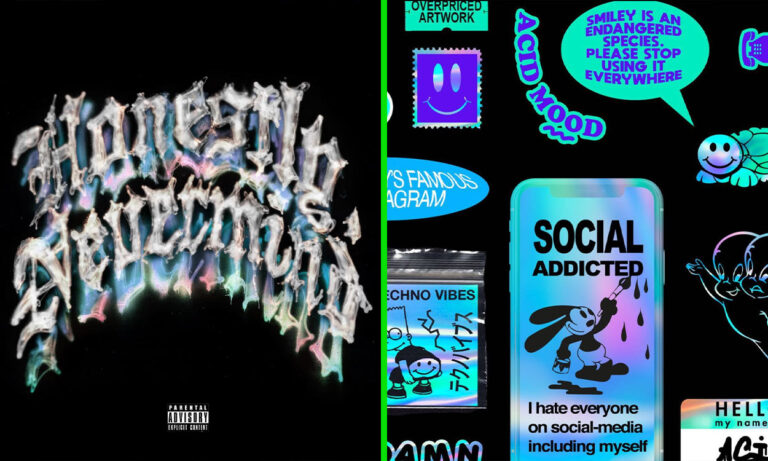What are acid graphics and why are they all over your TikTok FYP?

Put simply, acid graphics have a lot going on in them. Expect to see curving checkerboards, spiky cyberpunk fonts, shimmering organic shapes—you get the idea. When you first hear the term, you might think of LSD, hippies and the 60s, or maybe even acid house culture from the 90s. Both are right, but there’s still more to the picture.
Today, the trend pulls motifs, visuals and typography from both of these periods, while also being rooted in the current design landscape. As art and culture journalist Emily Gosling succinctly puts it, “this new style is tinged with irony and a darker sense of humour,” in contrast to the expansive optimism the graphics evoked during the “free love” era. So, why is this highly referential, somewhat anti-design trend constantly popping up on your TikTok FYP? Let’s get into it.
First, let’s pin down what’s going on with acid graphics stylistically. While speaking to Eye on Design, Hugo Hoppman, designer and art director, defines the style as having a “really trendy” look, paired with “super organic forms,” “crazy lettering,” and a “heavy metal aesthetic” drawing from 90s rave graphics.
However, these allusions to previous design trends are given a contemporary update due to the modern tools they’re created on. “Lots of rendering and 3D stuff, but also pretty trippy,” Hoppman further explains. For examples, check out
Acid graphics also have roots in 90s rave flyers—think bright neons, bold fonts, space-themed visuals and tongue-in-cheek references. One key difference this time around though is the infusion of futuristic, Y2K aesthetics, highly digital mediums and AI into these designs which were previously printed on paper. The combination of all of these competing elements results in a kind of anti-design.
Imogen Hoefkens, art director of 99 Designs, defines the latter term as “design that dismisses standard design principles, has colours that clash and type that’s illegible.” While anti-design may seem aggressive or even anti-user-friendly, Johnny Levanier, writer for 99 Designs, explains that it’s anything but. “Anti-designers are not seeking destruction, or ugliness for the sake of ugliness, but to offer an alternative to accepted design standards,” he says.
The characteristics of anti-design can be difficult to pin down because they aren’t constant—rather, it’s a direct reaction against current design standards. As Levanier puts it, “the most consistent trait that anti-design pieces share is the element of surprise.”
Today, anti-design looks like acid graphics, which fuse Y2K graphics, AI-generated images and shimmering, gothic fonts, to name just a few elements. The result? Visual designs that are exciting, even challenging at times—the direct opposite of clean-cut, almost barren 2010s minimalism. All in all, you could understand it as the graphic design world’s underground adoption of the current wave of maximalism.
Another potential reason for the trend? The prevalence of easy-to-use digital templates. Think of a tool like Canva, for instance. Previously, one would most likely be using Adobe’s Creative Suite to design birthday cards, promotional fliers, menus—the list goes on. But now, you don’t need hours of training on complex software systems to create an aesthetically pleasing website or an eye-catching poster. You can quite literally create one with the press of a button, especially now that AI is being integrated into the design world. As a result, acid graphics may be a reaction against these cookie-cutter templates from amateur and professional graphic designers.
Returning to the ‘acid’ of it all, there has also been an uptick in LSD consumption in the late 2010s and leading into the 2020s. According to freelance science journalist Rachel Nuwer in Scientific American, “researchers found that past-year LSD use increased by 56 per cent over three years,” from 2015 to 2018.
This resurgence is also taking place in the UK. A 2018 report from the Home Office shows that the number of 16 to 24-year-olds who took LSD tripled from 2012-2013 to 2014-2015, from 0.4 per cent to 1.2 per cent, respectively. This could be attributed to the growing trend of microdosing and increased knowledge of LSD’s potential mental health benefits. Moreover, Nuwer points to the drug’s boost in popularity as “fueled by a need for chemical escapism.”
With all this in mind, it seems inevitable that the complicated, prickly graphics are resonating with us now more than ever. These designs give us the nostalgic feel of prints, while also speaking to our digital literacy in a world increasingly flooded with AI-generated visuals. As the year progresses, expect to see experimental elements taken from this trend in more mainstream designs. Take Drake’s Honestly, Nevermind album cover art, for instance. All in all, whether you love them or hate them, acid graphics are here to stay.




